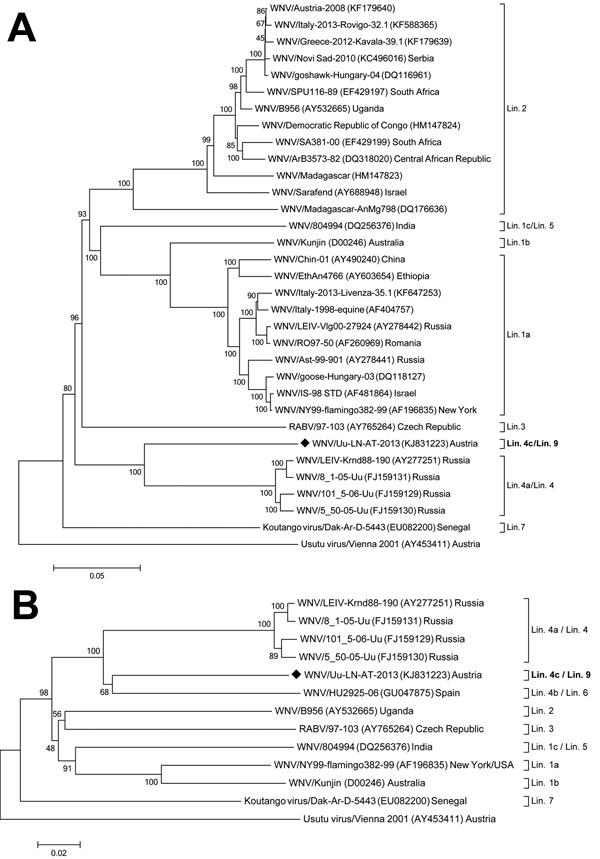Volume 20, Number 12—December 2014
Dispatch
Putative New West Nile Virus Lineage in Uranotaenia unguiculata Mosquitoes, Austria, 2013
Figure

Figure. Phylogenetic positioning of WNV-Uu-LN-AT-2013, a West Nile virus (WNV) strain newly identified in Austria, within the species West Nile virus. A) Phylogenetic position as determined on the basis of the full-length polyprotein-coding nucleotide sequences. B) Phylogenetic position as determined on the basis of 1,813-nt fragments of NS5, which enabled inclusion of the proposed lineage 6 virus. The evolutionary history was inferred by using the neighbor-joining method of MEGA5 (8) with 1,000-fold bootstrap analysis, rooted against the respective sequence of Usutu flavivirus. Numbers next to the branches indicate the percentage of replicates in the bootstrap analysis. Black diamond indicates the WNV sequence determined in this study. GenBank accession numbers are shown in parentheses with the virus names. Scale bars indicate nucleotide substitutions per site. Lin., lineage; RABV, Rabensburg virus.
References
- Gray TJ, Webb CE. A review of the epidemiological and clinical aspects of West Nile virus. Int J Gen Med. 2014;7:193–203.PubMedGoogle Scholar
- Fall G, Diallo M, Loucoubar C, Faye O, Sall AA. Vector competence of Culex neavei and Culex quinquefasciatus (Diptera: Culicidae) from Senegal for lineages 1, 2, Koutango and a putative new lineage of West Nile virus. Am J Trop Med Hyg. 2014;90:747–54 . DOIPubMedGoogle Scholar
- Lvov DK, Butenko AM, Gromashevsky VL, Kovtunov AI, Prilipov AG, Kinney R, West Nile virus and other zoonotic viruses in Russia: examples of emerging–reemerging situations. Arch Virol Suppl. 2004;18:85–96 .PubMedGoogle Scholar
- Vázquez A, Sánchez-Seco MP, Ruiz S, Molero F, Hernández L, Moreno J, Putative new lineage of West Nile virus, Spain. Emerg Infect Dis. 2010;16:549–52 . DOIPubMedGoogle Scholar
- Becker N, Petrič D, Zgomba M, Boase C, Madon M, Dahl C, Mosquitoes and their control, 2nd ed. Heidelberg (Germany): Springer Verlag; 2010. p. 91–111, 312–4.
- Scaramozzino N, Crance J-M, Jouan A, DeBriel DA, Stoll F, Garin D. Comparison of Flavivirus universal primer pairs and development of a rapid, highly sensitive heminested reverse transcription–PCR assay for detection of flaviviruses targeted to a conserved region of the NS5 gene sequences. J Clin Microbiol. 2001;39:1922–7 . DOIPubMedGoogle Scholar
- Kuno G, Chang GJ, Tsuchiya KR, Karabatsos N, Cropp CB. Phylogeny of the genus Flavivirus. J Virol. 1998;72:73–83 .PubMedGoogle Scholar
- Tamura K, Peterson D, Peterson N, Stecher G, Nei M, Kumar S. MEGA5: Molecular Evolutionary Genetics Analysis using maximum likelihood, evolutionary distance, and maximum parsimony methods. Mol Biol Evol. 2011;28:2731–9 . DOIPubMedGoogle Scholar
- Shirato K, Miyoshi H, Goto A, Ako Y, Ueki T, Kariwa H, Viral envelope protein glycosylation is a molecular determinant of the neuroinvasiveness of the New York strain of West Nile virus. J Gen Virol. 2004;85:3637–45 . DOIPubMedGoogle Scholar
- Whiteman MC, Wicker JA, Kinney RM, Huang CYH, Solomon T, Barrett ADT. Multiple amino acid changes at the first glycosylation motif in NS1 protein of West Nile virus are necessary for complete attenuation for mouse neuroinvasiveness. Vaccine. 2011;29:9702–10 . DOIPubMedGoogle Scholar
- Hall RA, Khromykh AA, Mackenzie JM, Scherret JH, Khromykh TI, Mackenzie JS. Loss of dimerisation of the nonstructural protein NS1 of Kunjin virus delays viral replication and reduces virulence in mice, but still allows secretion of NS1. Virology. 1999;264:66–75 . DOIPubMedGoogle Scholar
- Melian EB, Hinzman E, Nagasaki T, Firth AE, Wills NM, Nouwens AS, NS1′ of flaviviruses in the Japanese encephalitis virus serogroup is a product of ribosomal frameshifting and plays a role in viral neuroinvasiveness. J Virol. 2010;84:1641–7 . DOIPubMedGoogle Scholar
- Firth AE, Blitvich BJ, Wills NM, Miller CL, Atkins JF. Evidence for ribosomal frameshifting and a novel overlapping gene in the genomes of insect-specific flaviviruses. Virology. 2010;399:153–66 . DOIPubMedGoogle Scholar
- Aspöck H, Kunz C, Pretzmann G. Seasonal distribution of mosquitoes and its relation to the appearance of mosquito-borne viruses in the eastern part of the Neusiedlersee area (eastern Austria) [in German]. Zentralbl Bakteriol [Orig]. 1970;214:160–73 .PubMedGoogle Scholar
- Šebesta O, Halouzka J, Hubálek Z, Juřicová Z, Rudolf I, Šikutová S, Mosquito (Diptera: Culicidae) fauna in an area endemic for West Nile virus. J Vector Ecol. 2010;35:156–62 . DOIPubMedGoogle Scholar
1Current affiliation: Paracelsus Medical University, Salzburg, Austria.